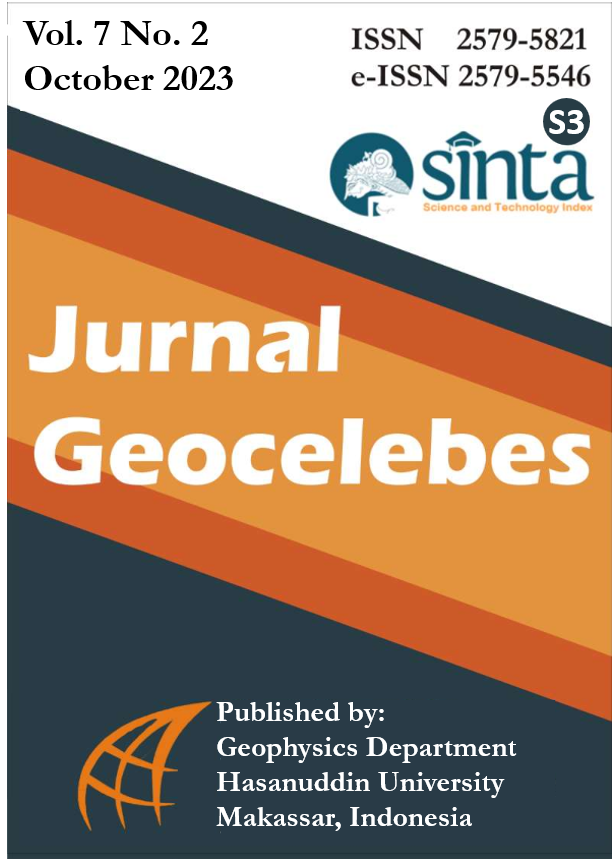Analysis of Seismotectonic Parameters and Earthquake Return Periods in The Nias Area (1980-2021)
Analisis Parameter Seismotektonik dan Periode Ulang Gempa Bumi di Wilayah Nias Tahun 1980-2021
DOI:
https://doi.org/10.20956/geocelebes.v7i2.22348Keywords:
a-value, b-value, likelihood, return period, seismicity indexAbstract
The Nias Islands region is an area prone to earthquakes with a very high level of earthquake activity. One reason is the source of the subduction zone which is in the northwest of the Nias Islands. The aim of this work is to determine the b-value, seismic index, and earthquake return period using probabilistic techniques. For the years 1980 to 2021, the Meteorology, Climatology and Geophysics Agency (BMKG) published data with a magnitude of 3-6.7 and a depth (H) of 10-300 Km. The research results obtained by calculating the highest b-value is 0.791 in South Nias district and the highest a-value is in the South Nias district of 3.97. Calculation of the highest seismicity index with a magnitude of 6.7 in South Nias district with a-value of 7.223191 with an earthquake return period of 14 years.Downloads
References
Anwar, S. (2019). Mengukur Peluang Kejadian Gempa Bumi dengan Lompatan Magnitudo di Wilayah Pulau Sumatera. Jurnal Lingkungan dan Bencana Geologi, 10(3), 159–170. http://dx.doi.org/10.34126/jlbg.v10i3.263
Aslamia, H., & Supardi, Z. A. I. (2022). Analisis Parameter a-Value Dan b-Value sebagai Mitigasi Bencana Gempa Bumi di Nusa Tenggara Timur. Jambura Physics Journal, 4(1), 14–27. https://doi.org/10.34312/jpj.v4i1.13815
BMKG. (2019). Katalog Gempabumi Signifikat dan Merusak 1821-2018. https://cdn.bmkg.go.id/web/katalog-gempabumi-signifikan-dan-merusak-1821-2018.pdf.
BNPB. (2018). Rencana Kontinjensi Menghadapi Bencana Tsunami Provinsi Sumatera Barat. https://bnpb.go.id/uploads/24/rencana-kontigensi-tsunami-sumatera-barat.pdf.
Daiana, S. T., Nurhidayah, & Handayani, L. (2021). Studi B-Value sebagai Analisis Seismisitas Berdasarkan Data Gempabumi Periode 1914–2020 (Studi Kasus: Provinsi Bengkulu). Jurnal Sain dan Teknologi Mitigasi Bencana, 16(1), 30–41. https://doi.org/10.29122/jstmb.v16i1.4860.
Damayanti, C., Yamko, A. K., Souisa, C. J., Barends, W., & Naroly, I. L. P. T. (2020). Pemodelan Segmentasi Mentawai-Pagai: Studi Kasus Gempa Megathrust di Indonesia. Jurnal Geosains Dan Remote Sensing, 1(2), 105–110. https://doi.org/10.23960/jgrs.2020.v1i2.56
Djamal, B., Gunawan, W., Simandjuntak, T. O., & Ratman, N. (1994). Peta Geologi Lembar Nias, Sumatera. Puslitbang Geologi. https://geologi.esdm.go.id/geomap/pages/preview/peta-geologi-lembar-nias-sumatera.
Ernandi, F. N., & Madlazim. (2020). Analisis variasi a-value dan b-value dengan menggunakan software zmap v. 6 sebagai indikator potensi gempa bumi di wilayah Nusa Tenggara Barat. Jurnal Inovasi Fisika Indonesia (IFI), 9(3), 24–30. https://doi.org/10.26740/ifi.v9n3.p24-30
Feng, C., Gao, G., Zhang, S., Sun, D., Zhu, S., Tan, C., & Ma, X. (2022). Fault slip potential induced by fluid injection in the Matouying enhanced geothermal system (EGS) field, Tangshan seismic region, North China. Natural Hazards and Earth System Sciences, 22, 2257–2287. https://doi.org/10.5194/nhess-22-22257-2022
Fidia, R., Pujiastuti, D., & Sabarani, A. (2018). Korelasi Tingkat Seismisitas dan Periode Ulang Gempa Bumi di Kepulauan Mentawai dengan Menggunakan Metode Guttenberg-Richter. Jurnal Fisika Unand, 7(1), 84–89. https://doi.org/10.25077/jfu.7.1.84-89.2018
Kijko, A., Vermeulen, P. J., & Smit, A. (2022). Estimation Techniques for Seismic Recurrence Parameters for Incomplete Catalogues. Surveys in Geophysics, 43, 597–617. https://doi.org/10.1007/s10712-021-09672-2
Lubis, L. H., Ayundita, A. A., Sari, N., & Wardono, W. (2022). Aktivitas Seismisitas Di Wilayah Sumatera Bagian Utara Menggunakan Arc-Gis Periode 2020-2021. Jurnal Kumparan Fisika, 5(2), 91–98. https://doi.org/10.33369/jkf.5.2.91-98
Madlazim, M. (2013). Kajian Awal tentang B Value Gempa Bumi di Sumatra. Jurnal Penelitian Fisika dan Aplikasinya (JPFA), 3(1), 41–46. https://doi.org/10.26740/jpfa.v3n1.p41-46.
Naimi-Ghassabian, N., Khatib, M., Nazari, H., & Heyhat, M-R. (2016). Fractal dimension and earthquake frequency-magnitude distribution in the North of Central-East Iran Blocks (NCEIB). Geopersia, 6(2), 243–264. https://doi.org/10.22059/jgeope.2016.58670.
Ningrum, R. W., Amelia, R. N., Taib, S., Achmad, R., & Aswan, M. (2022). Mapping of Seismic Vulnerability Potential for Earthquake Disaster Migitation in South Morotai. Jurnal Geocelebes, 6(1), 37–46. https://doi.org/10.20956/geocelebes.v6i1.19150.
Septiani, I., & Pujiastuti, D. (2021). Analisis Seismisitas Wilayah Kepulauan Maluku Periode 1970-2019 dengan Menggunakan Metode Likelihood. Jurnal Fisika Unand, 10(4), 461–466. https://doi.org/10.25077/jfu.10.4.461-466.2021
Suwandi, E. A., Sari, I. L., & Waslaluddin, W. (2017). Analisis Percepatan Tanah Maksimum, Intensitas Maksimum Dan Periode Ulang Gempa Untuk Menentukan Tingkat Kerentanan Seismik Di Jawa Barat (Periode Data Gempa Tahun 1974-2016). Wahana Fisika, 2(2), 78–96. https://ejournal.upi.edu/index.php/wafi/issue/view/953
Weiss, J. R., Ito, G., Brooks, B. A., Olive, J-A., Moore, G. F., & Foster, J. H. (2018). Formation of the frontal thrust zone of accretionary wedges. Earth and Planetary Science Letters, 495, 87–100. https://doi.org/10.1016/j.epsl.2018.05.010
Welkner, P. M. (1965). Statistical Analysis of Earthquake Occurrence in Japan, 1926–1956. Bulletin of the International Institute of Seismology and Earthquake Engineering, 2, 1–27.
Zaccagnino, D., Telesca, L., & Doglioni, C. (2022). Correlation between seismic activity and tidal stress perturbations highlights growing instability within the brittle crust. Scientific Reports, 12, 7109. https://doi.org/10.1038/s41598-022-11328-z
Downloads
Published
How to Cite
Issue
Section
License
Authors who publish with this journal agree to the following terms:
- Authors retain copyright and grant the journal right of first publication with the work simultaneously licensed under a Creative Commons Attribution License that allows others to share the work with an acknowledgement of the work's authorship and initial publication in this journal.
- Authors are able to enter into separate, additional contractual arrangements for the non-exclusive distribution of the journal's published version of the work (e.g., post it to an institutional repository or publish it in a book), with an acknowledgement of its initial publication in this journal.
- Authors are permitted and encouraged to post their work online (e.g., in institutional repositories or on their website) prior to and during the submission process, as it can lead to productive exchanges, as well as earlier and greater citation of published work (See The Effect of Open Access).



